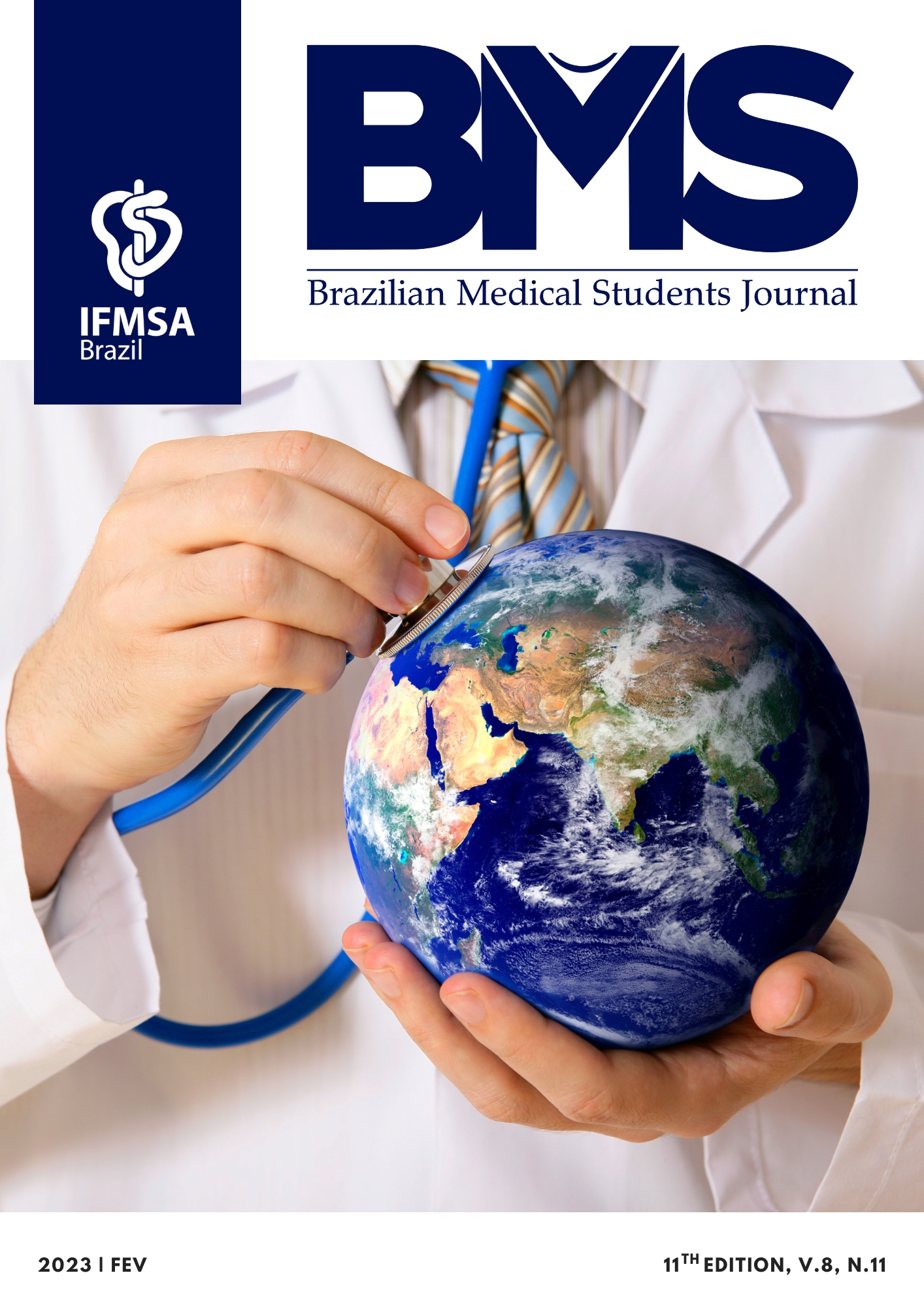Novas perspectivas farmacológicas para o tratamento da Fibrose Pulmonar Idiopática
Uma revisão bibliográfica integrativa
DOI:
https://doi.org/10.53843/bms.v8i11.352Keywords:
DOENÇAS PULMONARES INTERSTICIAIS, TRATAMENTO FARMACOLÓGICO, FIBROSE PULMONAR IDIOPÁTICAAbstract
ABSTRACT
Introduction: Idiopathic pulmonary fibrosis (IPF) is the most common form of the chronic fibrosing interstitial pneumonias. It courses with a slow progression associated with a clinical functional deterioration, resulting in chronic respiratory failure. It is predominantly seen in male patients, over 50 years of age. The aim of this study is to perform an integrative literature review on the pharmacological updates used for the treatment of this pathology. Method: The search strategy comprises the electronic databases Pubmed and Biblioteca Virtual em Saúde. The specific descriptors used were Idiopathic Pulmonary Fibrosis, treatments and symptom exacerbations. The search consisted of articles presented in full, written in English, Spanish or Portuguese, published from 2012 to 2020, totaling 226 titles. Results: After applying the inclusion criteria, which showed an updated therapy associated with Idiopathic Pulmonary Fibrosis, and, exclusion criteria, which showed no causal relationship with the theme, 15 articles were chosen. Discussion: IPF has a variable and unpredictable pathological history from the moment of diagnosis. The triggering pathophysiology is controversial, grouping repeated lesions in the alveolar epithelium, fibrosis and excessive deposition of extracellular matrix. Pharmacological treatment for IPF should consider the stage of the disease, prognostic factors, and associated comorbidities. In 2015, there was an update in therapy, proving the antifibrotic drugs, Pirfenidone and Nintedanib, as slowers the progression of the fibrotic condition and reducers of mortality from the disease. Conclusion: These drugs are safe and effective, promoting a decrease in the decrease in forced vital capacity and improving quality of life. The prescription of new drugs, when started early, has a beneficial action in slowing the progression of IPF.
Metrics
References
Xaubet A, Ancochea J, Bollo E, Fernández-Fabrellas E, Franquet T, Molina-Molina M, et al. Normativa sobre el diagnóstico y tratamiento de la fibrosis pulmonar idiopática. Archivos de Bronconeumología 2013;49. DOI: https://doi.org/10.1016/j.arbres.2013.03.011
Xaubet A, Ancochea J, Molina-Molina M. Fibrosis pulmonar idiopática. Medicina Clinica 2017;148:170–5. DOI: https://doi.org/10.1016/j.medcli.2016.11.004
Baddini-Martinez J, Baldi BG, Costa CH da, Jezler S, Lima MS, Rufino R. Update on diagnosis and treatment of idiopathic pulmonary fibrosis. Jornal Brasileiro de Pneumologia 2015;41. DOI: https://doi.org/10.1590/S1806-37132015000000152
Portela, R. G., & de Melo Barbosa, A. EFICÁCIA, SEGURANÇA E CUSTO-EFETIVIDADE DE PIRFENIDONA OU NINTEDANIBE PARA FIBROSE PULMONAR IDIOPÁTICA: REVISÃO RÁPIDA DE EVIDÊNCIAS. REVISTA CIENTÍFICA DA ESCOLA ESTADUAL DE SAÚDE PÚBLICA DE GOIÁS" CÂNDIDO SANTIAGO". 6(1).2020
Hoyer N, Prior TS, Bendstrup E, Wilcke T, Shaker SB. Risk factors for diagnostic delay in idiopathic pulmonary fibrosis. Respiratory Research 2019;20. DOI: https://doi.org/10.1186/s12931-019-1076-0
Tabaj Gabriela C, Sívori Martín, Cornejo Laura, Plotquin Martín. Experiencia en la Argentina del Programa de uso compasivo con nintedanib en el tratamiento de la Fibrosis Pulmonar Idiopática. Rev. am. med. respir. [Internet]. 2017 Jun [citado 2021 Ago 10] ; 17( 2 ): 126-130.Disponible en: http://www.scielo.org.ar/scielo.php?script=sci_arttext&pid=S1852-236X2017000200004&lng=es.
Kärkkäinen M, Nurmi H, Kettunen H-P, Selander T, Purokivi M, Kaarteenaho R. Underlying and immediate causes of death in patients with idiopathic pulmonary fibrosis. BMC Pulmonary Medicine 2018;18. DOI: https://doi.org/10.1186/s12890-018-0642-4
Xaubet A, Molina-Molina M, Acosta O, Bollo E, Castillo D, Fernández-Fabrellas E, et al. Guidelines for the medical treatment of idiopathic pulmonary fibrosis. Archivos de Bronconeumologia. 2017;53(5). DOI: https://doi.org/10.1016/j.arbr.2017.03.001
Molina-Molina M. The Future of Pharmacological Treatment in Idiopathic Pulmonary Fibroses. Archives de Br onconeumologia 2019;55:642-7. DOI: https://doi.org/10.1016/j.arbr.2019.05.012
Maher TM, Strek ME. Antifibrotic therapy for idiopathic pulmonary fibrosis: time to treat. Respiratory Research 2019;20. DOI: https://doi.org/10.1186/s12931-019-1161-4
Jeldres A, Labarca G. Is pirfenidone effective for idiopathic pulmonary fibrosis? Medway e 2017;17. DOI: https://doi.org/10.5867/medwave.2017.6844
Curbelo Pablo. Efectos adversos del nintedanib en un programa de uso compasivo. Rev. am. med. respir. [Internet]. 2017 Jun [citado 2021 Ago 10] ; 17( 2 ): 112-113. Disponible en: http://www.scielo.org.ar/scielo.php?script=sci_arttext&pid=S1852-236X2017000200001&lng=es.
Morell F, Villar A. Perspectivas en el tratamiento de la fibrosis pulmonar idiopática. Archivos de Bronconeumologia 2012;48:13–5. DOI: https://doi.org/10.1016/S0300-2896(12)70046-7
Maher TM, Lancaster LH, Jouneau S, Morrison L, Lederer DJ, Molina-Molina M, et al. Pirfenidone Treatment in Individuals with Idiopathic Pulmonary Fibrosis: Impact of Timing of Treatment Initiation. Annals of the American Thoracic Society 2019;16. DOI: https://doi.org/10.1513/AnnalsATS.201810-720RL
Davis S, Rafia R, Carroll C, Hamilton J, Essat M. Pirfenidone for Treating Idiopathic Pulmonary Fibrosis: An Evidence Review Group Perspective of a NICE Single Technology Appraisal. PharmacoEconomics 2019;37. DOI: https://doi.org/10.1007/s40273-018-0727-1
Downloads
Published
How to Cite
Issue
Section
License
Copyright (c) 2023 Vívian Raota, Carolina Lemos, Tainá Maier

This work is licensed under a Creative Commons Attribution 4.0 International License.
User licenses define how readers and the general public can use the article without needing other permissions. The Creative Commons public licenses provide a standard set of terms and conditions that creators and other rights holders can use to share original works of authorship and other material subjects to copyright and certain other rights specified in the public license available at https:// creativecommons.org/licenses/by/4.0/deed.pt_BR. Using the 4.0 International Public License, Brazilian Medical Students (BMS) grants the public permission to use published material under specified terms and conditions agreed to by the journal. By exercising the licensed rights, authors accept and agree to abide by the terms and conditions of the Creative Commons Attribution 4.0 International Public License.






